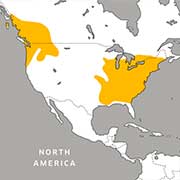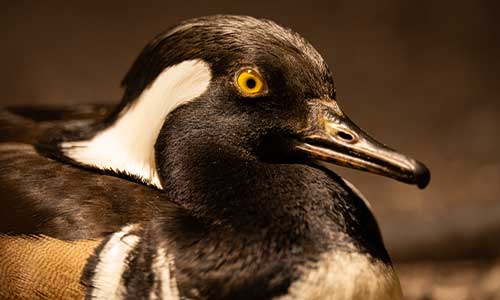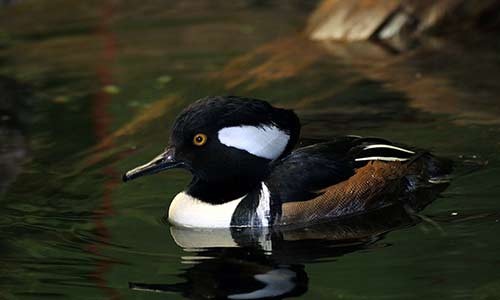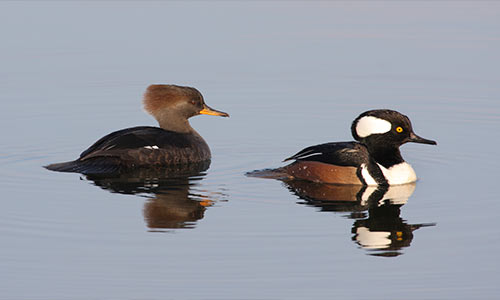Hooded Merganser
Lophodytes cucullatus
About the Hooded Merganser

Geographic Range:

Class: Aves
Order: Anseriformes
Family: Anatidae
Genus: Lophodytes
Species: cucullatus
Hooded mergansers have excellent vision, and their eyes are adapted to seeing clearly under water. Mergansers hunt for small aquatic prey by diving and swimming underwater, using their feet to propel them. These ducks exhibit sexual dimorphism, meaning males and females have different appearances.
Hooded Merganser Facts
Appearance:
Hooded mergansers are easily identifiable by their impressive collapsible crests. Males’ crests are black and white, while females’ are reddish-brown. Males are much more “sharply” colored, with black and white stripes and brown flanks. Females are more muted in appearance, with tones of brown.
Size:
- Weight: 1.5 pounds
- Length: 17.5 inches
Diet:
Small fish, crustaceans, aquatic insects.
Reproduction:
Hooded mergansers breed in the late winter or early spring. They typically lay 9-12 eggs, and occasionally lay their eggs in nests already built by other ducks. The eggs have an incubation period of 30-40 days.
Behavior:
Hooded mergansers have excellent vision, and their eyes are adapted to seeing clearly under water. Mergansers hunt for small aquatic prey by diving and swimming underwater, using their feet to propel them. These ducks exhibit sexual dimorphism, meaning males and females have different appearances. During breeding season, males will inflate their bold crests when their chosen female is nearby. They'll also emit low, gravelly calls.
Role in their habitat:
Mergansers act as a predators to small aquatic species and as prey to larger carnivores.
Habitat/range:
Hooded mergansers are found in North America. They dive for food in fresh water, and live in wooden lakes, rivers, forested wetlands, brackish estuaries, and tidal creeks.
Median Life Expectancy:
11.5 years
Fun Facts
- Hooded Mergansers have excellent eyesight, easily finding prey under the water.
- They exhibit sexual dimorphism, with males having a distinct black and white head. While the females have various muted tones of brown.
You Can Find This Animal in the Alfred Huang North American Crane Habitat
You might also like
At Franklin Park Zoo:
At Stone Zoo:









